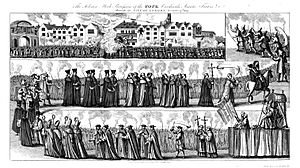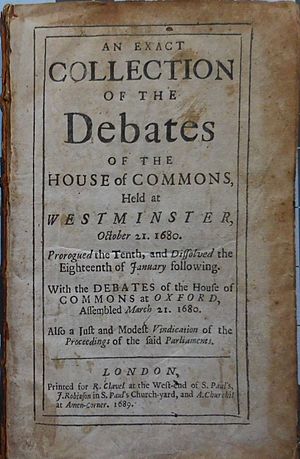Exclusion Bill Parliament facts for kids
The Exclusion Bill Parliament was a special meeting of the Parliament of England during the time of Charles II of England. It got its name because of a big debate about something called the Exclusion Bill. This Parliament was called on 24 July 1679, but King Charles II delayed its start until 21 October 1680. It only lasted for three months, ending on 18 January 1681.
Contents
Why This Parliament Was Important
What Was Happening Before?
This Parliament was the third one during King Charles II's rule. It came after the long Cavalier Parliament and a very short one called the Habeas Corpus Parliament. What made this Parliament special was the big worry in England about a "Popish Plot". Many people feared that Catholics were planning to harm the King and take over the country.
The Idea of the Exclusion Bill
Because of these fears, a group of people led by Anthony Ashley Cooper, 1st Earl of Shaftesbury, came up with an idea. On 15 May 1679, they suggested the Exclusion Bill in the House of Commons. The main goal of this bill was to stop the King's brother, James, Duke of York, from becoming the next king. Why? Because James was Catholic. Some people even thought that Charles's son, the Duke of Monmouth, should be the next king instead.
It looked like the Exclusion Bill might pass. So, King Charles II used his royal power to close down Parliament. He did this to stop the bill from becoming law.
The Parliament's Journey
Calling a New Parliament
A new Parliament was called on 24 July 1679. Elections for the new House of Commons happened over the next few weeks. The results were not good for the King's supporters.
Parliament was supposed to meet in October 1679. But King Charles delayed it again until 26 January 1680. Shaftesbury was worried the King might not let this new Parliament meet at all. So, he started a campaign where people signed petitions to pressure the King. He also told the Duke of Monmouth to come back from where he was living away from England. On 27 November 1679, Monmouth arrived in London, and many people celebrated.
Petitions and Protests
On 7 December 1679, Shaftesbury and fifteen other important people, known as Whig peers, signed a petition asking Charles to let Parliament meet. Then, on 13 January 1680, another petition with 20,000 signatures was given to the King.
But instead of letting Parliament meet, Charles delayed it even more. He also brought his brother, the Duke of York, back from Scotland. Because of this, Shaftesbury asked his friends on the King's special advisory group, the Privy Council, to quit. Four of them did.
The "Abhorrers" Respond
Not everyone agreed with Shaftesbury. People like George Jeffreys and Francis Wythens started a movement called the "Abhorrers." They wrote messages saying they disliked the petitions and supported the King's actions. This idea spread across England, and the Abhorrers' messages were a strong response to the Petitioners.
Shaftesbury's group tried to keep the fears about the "Popish Plot" alive. They organized large parades in London where they burned a fake Pope. The King's supporters, however, reminded people of the strict rules during the time of Oliver Cromwell and the Commonwealth government. The King called Shaftesbury's group "troublemakers" and "nonconformists" (people who didn't follow the official church). By early 1681, Shaftesbury's big movement had quieted down.
Whigs and Tories
During this time, Shaftesbury's supporters became known as the Whigs. They kept trying to pass the Exclusion Bill. King Charles was pretty sure it would pass in the House of Commons, even if it didn't pass in the House of Lords.
The King and his brother's supporters were mostly High Anglicans. They were against the Exclusion Bill and were first called the Abhorrers. Later, they became known as the Tories.
Challenges for the Duke of York
On 26 June 1680, Shaftesbury led a group that tried to formally accuse the Duke of York. They said he was a Catholic who wasn't following the laws. But before the group could do anything, they were stopped for getting involved in government matters. The next week, Shaftesbury tried again, but the group was stopped once more.
Parliament Finally Meets
Parliament finally met on 21 October 1680. The House of Commons chose William Williams as their Speaker for the first time. He was the first Speaker from Wales.
On 23 October, Shaftesbury asked the House of Lords to look into the "Popish Plot" again. The Exclusion Bill, which everyone expected, passed in the Commons. It then went to the Lords on 15 November. Shaftesbury gave a powerful speech supporting it, but the Lords voted against the Bill by 63 votes to 30.
The Lords wanted to find other ways to limit the power of a Catholic king. But Shaftesbury argued that the only real choice was to stop James from becoming king or for King Charles to marry again and have a new heir.
On 23 December 1680, Shaftesbury gave another strong speech for the Exclusion Bill in the Lords. He spoke against the Duke of York and said he didn't trust Charles II. He also told Parliament not to approve any more taxes until "the King shall satisfy the People, that what we give is not to make us Slaves and Papists."
Parliament was looking deeply into the supposed Irish plot and threatening to accuse some of the King's judges. So, Charles delayed Parliament on 10 January 1681 and then officially closed it on 18 January. He called for new elections, planning for the next Parliament to meet in Oxford.
On 25 January, Shaftesbury and other important people asked the King to hold Parliament in Westminster Hall instead of Oxford. But the King stuck to his plan. The next Parliament was indeed the Oxford Parliament of 1681.
See also
- List of parliaments of England
- English general election, 1679 (October)



